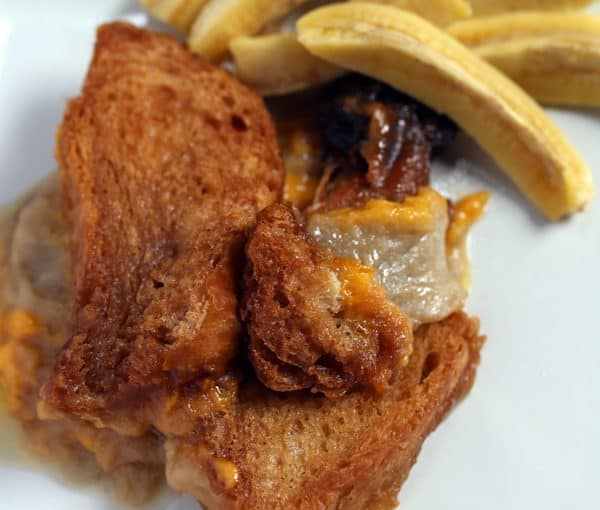
A Bit of Capirotada History
Capirotada is one of those recipes that is amazingly chock full of history, with the added bonus of being unbelievably delectable. My local super market was selling bags of pre-toasted bread, which was my excuse to assemble one of these bread puddings for Good Friday.
A capirote is the Spanish name for a brown, hooded vestment worn by monks in the Catholic faith. The Capuchin monks derived their name from this vestment, as that is what they wore. My favorite coffee beverage, cappuccino is named for these monks, and I assume that Capirotada got its name the same way. Did Capuchin monks make cappuccino and Capirotada? Maybe. More than likely the beverage and the bread pudding were named because of their similarity to the brown color of the capirote vestment.
Back several hundred years ago, Capirotada was a savory meat and potato casserole. But through the years, the dish turned into a meatless, sweetened bread pudding. Perhaps the monks had some influence on Capirotada in converting this casserole into a meatless dish for mandated Friday and Lenten fasting. The added filling of cheese keeps the Capirotada substantial and filling while abstaining from meat.
The original recipe for Capirotada appeared in the Americas with the arrival of the Spanish colonists, and is still enjoyed throughout the Americas today. In my home town, Capirotada is a big deal during Semana Santa, or Holy Week. And that’s why every supermarket has pre-toasted bags of bread ready for folks like me that just have satisfy that annual, Springtime craving. It’s a craving that has existed in this region for around 400 years. Blows my mind we still make it the same way the colonists did.
Mixing Up The Recipe For Modern Tastes
Like naming a baby Ethel or Orville, serving desserts made with dried prunes has simply gone out of fashion. Capirotada is usually stuffed with loads of dried prunes, which sends an awkward message when you show up for the Easter picnic. “Hey y’all! After all that ham and deviled eggs…” you know how that conversation would roll. So let’s stop there. Instead of prunes, I bought a small bag of mixed dried fruit, which contained apples, apricots, pears, and maybe one prune. Unlike a load of prunes, a single prune is not a message. It’s just a prune.
I also elected the wrong size Dutch oven for baking my Capirotada. And as you will see from the pictures, I now need to clean my oven. But we enjoyed the Capirotada nonetheless. I’m sure I will make it again next year, just in a larger pot.
- Green onions browning in butter smells heavenly!
- Pour the sauteed onions through a mesh sieve.
- Press the sauteed onions to release more butter and more flavor.
- Making the flavor tea with piloncillo, 2 kinds of anise and cinnamon
- Remove the spices, and add the dried fruit
- Brush the toasted bread with the onion flavored melted butter
- Ladling over the fruit
- First Layer of Cheese! I used mild cheddar
- Next layer of bread
- Another layer of fruit
- Final layer of Cheese
- Brushing the top layer of bread with melted butter
- Topping off the Capirotada
- Capirotada in the pot – A little crammed
- Blam! – Capirotada explosion!
- Beautifully golden brown Capirotada
- In spite of the mess, a picture perfect Capirotada
- A warm, heaping spoonful of scrumptious capirotada
- Golden brown delicious Capirotada
- The Dominico bananas were the perfect addition to the Capirotada, but do they look like french fries in this pic?
Mixed Fruit Capirotada for Good Friday
Capirotada is a traditional bread pudding that is enjoyed during Lent throughout Latin America
- Prep Time: 20 mins
- Cook Time: 1 hour
- Total Time: 1 hour 20 minutes
- Yield: 12 servings 1x
- Category: Dessert
- Cuisine: Latin
Ingredients
- 8 oz. dense French bread, sliced into 1-inch-thick slices (day-old bread is the best) (250gr)
- 1 1/2 sticks butter (172 gr)
- 6 green onions, chopped
- 1/4 tsp. freshly ground black pepper (<1gr)
- 2 qts. water (2lt)
- 1/2 teaspoon anise seed (<1gr)
- 4 pieces star anise
- 2 whole cinnamon sticks
- 8 oz piloncillo, or 3/4 cup packed brown sugar (250gr)
- 1/4 cup golden raisins (40gr)
- 7 oz. mixed dried fruit, chopped (198gr)
- 3/4 cup pecans, roughly chopped (optional) (75gr)
- 12 oz. cheese, thinly sliced (375gr)
- Fresh bananas for garnish (I used Dominico mini bananas)
Instructions
- Preheat oven to 375 degrees.
- To prepare bread: On an ungreased cookie sheet, toast bread under oven broiler until golden on each side. Set aside.
- To prepare tea and fruit: Bring water to a boil in a large pot. Place anise seeds and star anise in a metal tea ball, and add to water. Add the cinnamon sticks and piloncillo. Boil for 10 minutes. Using a slotted spoon, remove the whole spices.
- Add mixed fruit and raisins to the tea, and allow to steep for 5 minutes.
- In a deep 4-6 quart (4-6lt) casserole, melt the butter. Add the onions and ground black pepper. Saute the onions and butter over low heat for about 3 minutes. Remove from heat, and pour the butter through a fine mesh strainer. Remove and discard and the onions.
- Brush each of the pieces of bread with the melted butter.
- In the baking dish, place ingredients in layers, starting with a single layer of bread. Cut smaller pieces of bread to fill large gaps.
- Using a slotted spoon, remove some of the fruit from the tea, and distribute evenly over the bread layer.
- Over the fruit, add a layer of cheese. Sprinkle in optional pecans, if desired.
- Place another layer of butter basted bread over the cheese, and continue to layer with fruit, cheese and then a final layer of bread on top.
- Cover the baking dish with lid or aluminum foil.
- Bake the bread pudding for 1 hour. To test for doneness, tilt the baking dish to see if any liquid becomes visible. If so, continue baking the capirotada until all the liquid is absorbed by the bread.
- Serve the capirotada garnished with sliced bananas.


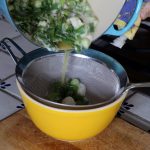


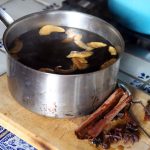
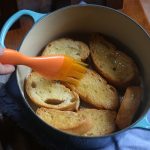
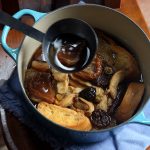
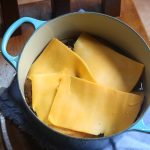
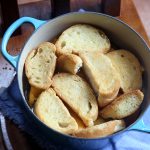
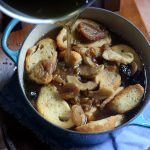
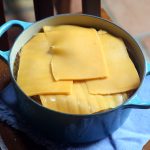
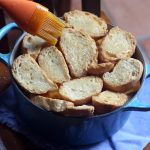
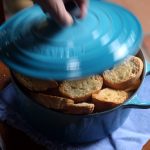


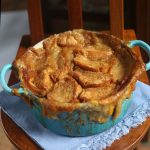
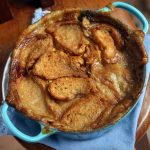
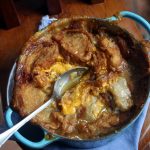
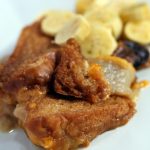
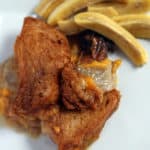
Leave a Reply